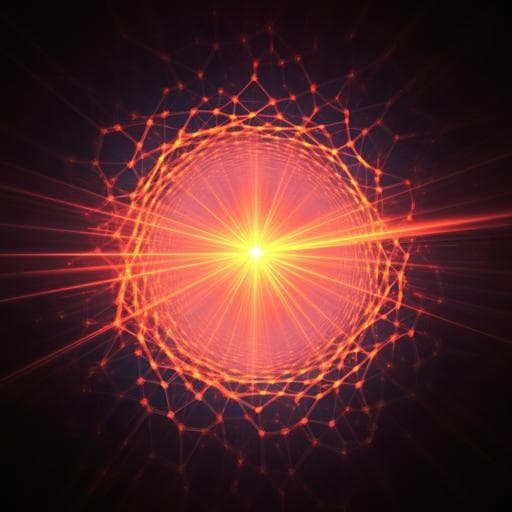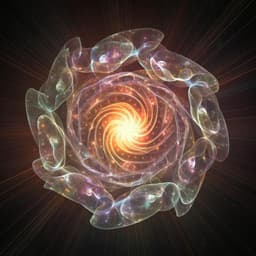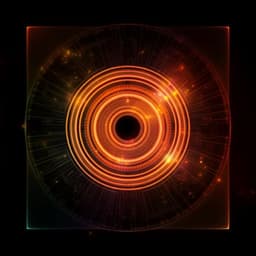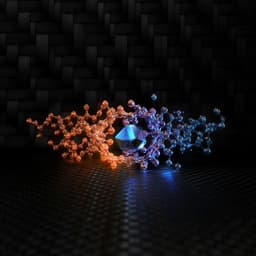
Physics
Exciton polariton condensation from bound states in the continuum at room temperature
X. Wu, S. Zhang, et al.
This groundbreaking study by Xianxin Wu, Shuai Zhang, and their colleagues reveals room-temperature bound states in the continuum polariton condensation using cesium lead bromide perovskite. The research highlights the achievement of strong coupling and directional vortex beam emission with long-range coherence, pushing the boundaries of photonic and topological circuits.
~3 min • Beginner • English
Introduction
The study addresses whether bound states in the continuum (BIC) can enable room-temperature exciton-polariton condensation by providing ultra-high-Q photonic modes that enhance exciton-photon coupling and polariton lifetime. Prior BIC-polariton condensates have required cryogenic conditions due to low exciton binding energies in III-V semiconductors. Lead-halide perovskites, particularly CsPbBr3, possess large exciton binding energies, high optical gain, tunable bandgaps, and good processability, making them promising for room-temperature polaritonics. The work aims to realize BIC polariton condensation in a compact, planar perovskite photonic crystal (PhC) without bulky Fabry–Pérot microcavities, demonstrate its coherence and topological vortex emission, and show nonlinear control via switching between miniaturized BIC modes.
Literature Review
BICs exhibit theoretically infinite Q factors and non-radiative characteristics, enabling vortex-beam generation, topological modulation, low-threshold nanolasers, and polariton accumulation. BIC polariton condensation was previously demonstrated in patterned GaAs/(Al,Ga)As waveguides at cryogenic temperatures. Perovskite microcavities have enabled room-temperature polariton lasing and condensation, and have been used to explore quantum fluids and non-Abelian gauge fields. Perovskite single crystals have shown BIC photonic lasing but strong-coupling BIC polariton condensation in such structures had not been realized. Recent demonstrations include room-temperature polariton condensation in organic systems combined with BICs in metasurfaces, underscoring the broad potential of BIC-polaritons. The gap this work addresses is achieving BIC-driven polariton condensation at room temperature in an all-inorganic perovskite PhC platform without vertical Fabry–Pérot cavities, while exploiting their topological properties and nonlinearities.
Methodology
Materials and device fabrication: Single-crystalline CsPbBr3 microplatelets (>20 μm lateral size) were grown on Si/SiO2 substrates via chemical vapor deposition using CsBr and PbBr2 precursors heated to 575 °C in N2 (200 Torr, 40 sccm), then cooled to room temperature. The growth yielded vertically oriented, atomically smooth platelets with narrow PL FWHM (~60.7 meV) and single-exponential decay (~6.0 ns). A periodic air-hole PhC lattice was patterned into the microplatelets using focused ion-beam (FIB) milling (FEI Nova 200) with optimized dwell times (≤2 ms) and low beam currents (<10 pA). Typical structural parameters included thickness h ~145 ± 5 nm (example device 150 nm), lattice period a = 290–300 nm (example 300 nm), and hole sizes (example diameter 150 nm; another device radius r = 57 nm). A 30 nm PMMA capping layer was spin-coated for protection and refractive index matching.
Optical characterization: Angle-resolved reflectance and photoluminescence (PL) were measured using a custom Fourier imaging system with a 50×, NA = 0.8 objective, collecting spectra on a Horiba IHR-550 spectrometer. Non-resonant pulsed excitation at 400 nm (frequency-doubled 800 nm; ~300 fs pulses, 1 kHz repetition) was used, with an expanded square pump spot (~10 μm). Power-dependent emission was recorded to determine threshold behavior, linewidth narrowing, and energy blueshift. Time- and angle-resolved PL snapshots were obtained using an optical Kerr gate (OKG) synchronized with the excitation, providing sub-picosecond temporal resolution. Below threshold lifetimes were measured by TCSPC using a 400 nm, 80 MHz Ti:sapphire oscillator source and a 100×, NA 0.9 objective (~40 ps resolution). Spatial and temporal coherence were probed with a Michelson interferometer to obtain first-order correlation g(1) at zero and finite delays. Momentum-space (back focal plane) imaging captured far-field emission below and above threshold; polarization-resolved BFP images were recorded for H, V, D, A, R, and L to compute Stokes parameters S1–S3 and identify polarization singularities. Self-interference in k-space verified phase singularities and orbital angular momentum.
Nonlinear switching experiments: Two pump beams (signal and weaker gate beam, with tunable temporal delay) were configured; the signal illuminated the whole PhC lattice while the gate illuminated half of it to enhance switching. Delay-dependent angle-resolved and far-field patterns were recorded to monitor mode switching between miniaturized BIC modes M11 and M12.
Numerical simulations: Lumerical FDTD was used to compute TM-polarized mode dispersions, Q factors, and Fourier-space distributions. Geometries were taken from SEM measurements; wavelength-dependent complex permittivity of CsPbBr3 was from literature. Simulated angle-resolved reflection and far-field patterns are detailed in the Supplementary Notes.
Key Findings
• Strong exciton–photon coupling in CsPbBr3 PhC lattices produced lower polariton branches (LP2, LP3) with a Rabi splitting of 158 meV and detuning Δ = −74.6 meV. Upper polariton branches were not observed due to strong absorption above the exciton energy.
• Formation of symmetry-protected BIC polariton modes was evidenced by linewidth narrowing of LP3 from 18.8 meV to 2.5 meV near the Γ point, corresponding to a Q ~ 913 in reflectance.
• Room-temperature BIC polariton condensation was observed at the dispersion saddle point (two-lobe emission) under pulsed non-resonant excitation. Across the threshold P_th, the emission intensity transitioned from linear to superlinear, linewidth narrowed, and energy blueshifted. Blueshift slopes differentiated polariton–reservoir (below threshold) and polariton–polariton (above threshold) interactions.
• Samples with weaker negative detuning (Δ ≈ −64.1 meV) showed lower thresholds and larger blueshift slopes, consistent with higher excitonic fraction and enhanced nonlinearity.
• Condensation dynamics: two-lobe BIC polariton emission established within ~0.8 ps at ~1.6 P_th and redshifted during decay as density and interactions decreased; the momentum profile remained on the BIC mode throughout.
• Coherence: Long-range spatial coherence extended across the whole PhC lattice above threshold. Temporal coherence time of the condensate was 2.14 ± 0.16 ps, about an order of magnitude longer than the pump (0.31 ± 0.01 ps). Coherence time decreased with pump due to phase decoherence from polariton–polariton scattering.
• Far-field vortex emission: Above threshold, the BFP image transformed into a donut-shaped pattern with dominant in-plane momentum ~0.1 k0 and a central singularity at Γ, indicating collimated normal emission and non-radiative BIC character. Polarization-resolved Stokes maps revealed a polarization vortex with topological charge l = −1/2 at Γ. Self-interference in k-space showed fork dislocations consistent with orbital angular momentum of l = −1 inherited from the BIC mode.
• Nonlinear switching of miniaturized BIC modes: In finite-size lattices, BICs transformed into localized modes Mpq. Using a delayed weak gate beam, the M12 mode could be switched on/off relative to the fundamental M11 via polariton–polariton scattering and condensate density evolution. The M12 intensity dropped by ~12.5 dB within 17 ps near zero delay; far-field patterns switched from M12-dominated to M11 at positive delays. Polarization singularity at Γ was preserved in both modes, indicating symmetry-protected BIC nature rather than accidental BIC.
• Threshold comparison under quasi-CW excitation (100 ns pulses, 100 kHz) at 80 K showed >50% lower threshold for BIC polariton condensation relative to photonic lasing in pristine microplatelets of similar size.
Discussion
The results demonstrate that coupling perovskite excitons to symmetry-protected BIC modes in a planar PhC lattice provides the ultra-high effective Q factors and reduced radiative losses required to accumulate polaritons and achieve condensation at room temperature. The observed threshold behavior, linewidth narrowing, energy blueshift regimes, and the emergence of long-range spatial and temporal coherence collectively confirm BEC-like polariton condensation on a BIC mode. The far-field donut beam with polarization and phase singularities evidences the topological nature of the condensate emission, enabling coherent vortex beams with low divergence along the surface normal. The ability to switch between miniaturized BIC modes while preserving the topological singularity showcases controllable nonlinear mode management in compact structures, pointing to practical, integrated polaritonic circuits with additional degrees of freedom such as orbital angular momentum. Compared to photonic lasing, the demonstrated threshold reduction (at 80 K) and the strong-coupling indicators suggest a promising route toward low-power, on-chip coherent sources and topological light manipulation at and above room temperature.
Conclusion
This work realizes room-temperature BIC polariton condensation in air-hole CsPbBr3 photonic crystal lattices without bulky vertical cavities. The symmetry-protected BIC provides a high-quality optical environment that supports strong exciton–photon coupling (Rabi splitting 158 meV), enabling condensates with long-range coherence and emission as vortex beams carrying topological charge. Furthermore, nonlinear polariton interactions enable efficient switching among miniaturized BIC modes (e.g., M11 and M12) while preserving their polarization singularity. These advances establish a platform for integrated polaritonic and topological photonic devices at room temperature.
Future directions include optimizing material quality and nanofabrication to further increase cavity Q and extend coherence times, identifying and controlling upper polariton branches, achieving truly continuous-wave room-temperature operation, and engineering complex lattices for programmable topological states and multi-mode OAM control.
Limitations
• The polariton lifetime is limited by the finite cavity quality factor; improved fabrication could enhance Q and coherence times. • Condensation was observed only for TM polarization, likely due to higher excitonic fraction and longer lifetime for TM, indicating polarization-dependent performance. • Upper polariton branches were not resolved because of strong absorption above the exciton energy. • While quasi-CW operation was shown at 80 K, room-temperature experiments employed pulsed excitation; continuous-wave operation at room temperature remains to be demonstrated.
Related Publications
Explore these studies to deepen your understanding of the subject.







